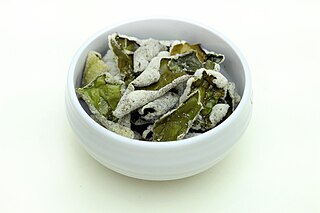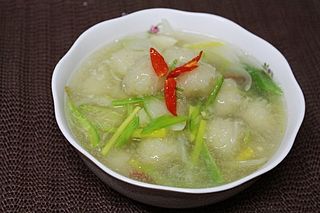Perilla may refer to any of the following subjects:

Perilla frutescensvar.crispa, also known by its Japanese name shiso, is a cultigen of Perilla frutescens, an herb in the mint family Lamiaceae. It is native to the mountainous regions of China and India, but is now found worldwide. The plant occurs in several forms, as defined by the characteristics of their leaves, including red, green, bicolor, and ruffled. Shiso is perennial and may be cultivated as an annual in temperate climates. Different parts of the plant are used in East Asian and Southeast Asian cuisine.

Ocimum is a genus of aromatic annual and perennial herbs and shrubs in the family Lamiaceae, native to the tropical and warm temperate regions of all 6 inhabited continents, with the greatest number of species in Africa. It is the genus of basil and its best known species are the cooking herb great basil, O. basilicum, and the medicinal herb tulsi, O. tenuiflorum.

Leaf vegetables, also called leafy greens, pot herbs, vegetable greens, or simply greens, are plant leaves eaten as a vegetable, sometimes accompanied by tender petioles and shoots. Leaf vegetables eaten raw in a salad can be called salad greens.

Perilla ketone is a natural terpenoid that consists of a furan ring with a six-carbon side chain containing a ketone functional group. It is a colorless oil that is sensitive to oxygen, becoming colored upon standing. The ketone was identified in 1943 by Sebe as the main component of the essential oil of Perilla frutescens. Perilla ketone is present in the leaves and seeds of purple mint, which is toxic to some animals. When cattle and horses consume purple mint when grazing in fields in which it grows, the perilla ketone causes pulmonary edema leading to a condition sometimes called perilla mint toxicosis.

Perilla oil is an edible vegetable oil derived from perilla seeds. Having a distinct nutty aroma and taste, the oil pressed from the toasted perilla seeds is used as a flavor enhancer, condiment, and cooking oil in Korean cuisine. The oil pressed from untoasted perilla seeds is used for non-culinary purposes.
Perilla nankinensis may refer to:

Perilla frutescens, also called deulkkae or Korean perilla, is a species of Perilla in the mint family Lamiaceae. It is an annual plant native to Southeast Asia and Indian highlands, and is traditionally grown in the Korean peninsula, southern China, Japan and India as a crop.

Bugak (부각) is a variety of vegetarian twigim in Korean cuisine. It is made by deep frying dried vegetables or seaweed coated with chapssal-pul and then drying them again. It is eaten as banchan or anju. Common ingredients are green chili peppers, perilla leaves, perilla inflorescence, camellia leaves, chrysanthemum leaves, burdock leaves, tree of heaven shoots, potatoes, gim (laver), and dasima (kelp). Vegetable oils such as perilla oil or soybean oil are typically used for frying.

Gamja-ongsimi (감자옹심이) or potato dough soup is a variety of sujebi in Korea's Gangwon cuisine. Both the potato dumplings and the soup can be referred to as gamja-ongsimi. The juk (porridge) made with potato balls as its ingredient is called gamja-ongsimi-juk, and the kal-guksu made with the potato balls is called gamja-ongsimi-kal-guksu.
Shisho may refer to:

Manipuri cuisine refers to the cuisine of Manipur, a state of northeastern India. Daily meals are based on rice, with a few side dishes of vegetables, fish and meat. A meal would usually have a vegetable stew called ensaang or athongba, flavored with dried or fried fish; stir-fried vegetables called kanghou; and a spicy item, which could be morok metpa, eromba, or singju. All piquant side dishes are accompanied by a choice of fresh herbs, collectively called maroi. The base and essence of Meitei cuisine is the fermented fish called ngari. Several dishes of meat, mostly chicken and pork, are cooked with unique recipes. As a result of religious taboos, however, the Meitei Pangals do not cook the latter.
"Wild basil" is a common name for several plants in the mint family (Lamiaceae):
The following outline is provided as an overview of and topical guide to herbs and spices:

Singju is a dish from Manipur. It originated with the Meitei-culture but has been widely adopted by most of the ethnic communities of the state and in some neighbouring states of Northeast India. Often served as a spicy side dish, it is also popular as an afternoon or evening snack.

Perillene is a natural monoterpene that consists of a furan ring with a six-carbon homoprenyl side chain. Perillene is a component of the essential oil obtained by extraction of the leaves of Perilla frutescens. Perillene has also been obtained by steam distillation of the leaves of Perilla frutescens. Perillene has been found to elicit distinct electrophysiological responses in the antennae of the apple blossom weevil. It has been suggested that perillene is one several molecules in the emanation bouquet of apple tree buds which may be used by adult weevils as chemical cues to discrimination during host-searching behavior.
Nocardioides perillae is a Gram-positive and rod-shaped bacterium from the genus Nocardioides which has been isolated from the roots of the plant Perilla frutescens from a suburb of Beijing, China. Nocardioides perillae produces the menaquinone MK-8(H4).

Perilla is a genus consisting of one major Asiatic crop species Perilla frutescens and a few wild species in nature belonging to the mint family, Lamiaceae. The genus encompasses several distinct varieties of Asian herb, seed, and vegetable crop, including P. frutescens (deulkkae) and P. frutescens var. crispa (shiso). The genus name Perilla is also a frequently employed common name ("perilla"), applicable to all varieties. Perilla varieties are cross-fertile and intra-specific hybridization occurs naturally. Some varieties are considered invasive.
Silam may refer to: